Govt Push Paves Way For OTR Recycling In Australia
- By Gaurav Nandi
- February 28, 2025

The Australian Government’s push for end-of-life tyre recycling, particularly through the use of crumb rubber in road construction, has been gaining momentum. With Western Australia and Queensland continuing to grow rapidly but key markets like Victoria falling away, challenges remain in expanding the use of crumb rubber, especially in New South Wales and South Australia. However, partnerships like that between Tyrecycle and Alcoa Australia are helping pave the way for the recycling of OTR tyres, creating new opportunities.
The Australian Government’s endeavour for recycling end-of-life (ELT) tyres has been lauded by industry experts in many mature markets. Since December 2021, Australia has prohibited the export of whole baled tyres, except for specific casings and retreads. The Australian Government emphasises a circular economy approach, which includes incentives for local manufacturing by procuring tyre-derived materials such as crumb rubber for asphalt and other civil applications. The Western Australian Government has used over 3,000 tonnes of crumb rubber for road projects in a single year.
However, challenges remain with the recycling of off-the-road (OTR) tyres, often disposed of at mining sites. Nonetheless, the proactive nature of the government, especially in Western Australia, has paved the way for OTR tyre recycling, with recyclers forming partnerships with mining companies to ensure a steady stream of supply.
One such collaboration is between Tyrecycle, the recycling arm of ResourceCo, and Alcoa Australia. Tyrecycle’s state-of-the-art recycling facility in East Rockingham, 40 kilometres south of Perth, has already welcomed its first load of used OTR tyres from Alcoa, which is a bauxite mining company.
Speaking to Tyre Trends on the current state of waste OTR tyres, Tyrecycle Chief Executive Officer Jim Fairweather stated, “Currently, an estimated 130,000 tonnes of OTR tyres are discarded annually; 50,000 tonnes in The Pilbara alone. Tyrecycle is processing about 15,000 tonnes per year and aims to expand its footprint into key mining regions like the Hunter Valley, Bowen Basin and Pilbara. These areas are pivotal to Australia’s coal and iron ore mining industries, presenting significant opportunities for waste management and resource recovery.”
He added, “Mining operators often choose the cost-effective route of burying waste tyres on-site, which hinders recycling efforts. While some companies recognise the importance of responsible waste management, regulatory enforcement is needed to make recycling a standard practice. Proactive companies in the mining sector are stepping up, recognising the reputational and environmental risks associated with poor waste management. However, broader adoption is hampered by minimal regulatory mandates.”
COLLABORATIVE MEASURES
The collaboration between Tyrecycle and Alcoa was driven by a mutual commitment to sustainable practices and innovation in waste management. For the recycler, it represented a strategic move to expand its capacity to process OTR tyres and, in the future, conveyor belts, which are significant waste streams in the mining sector. This partnership evolved over five years of discussions, trials and project planning.
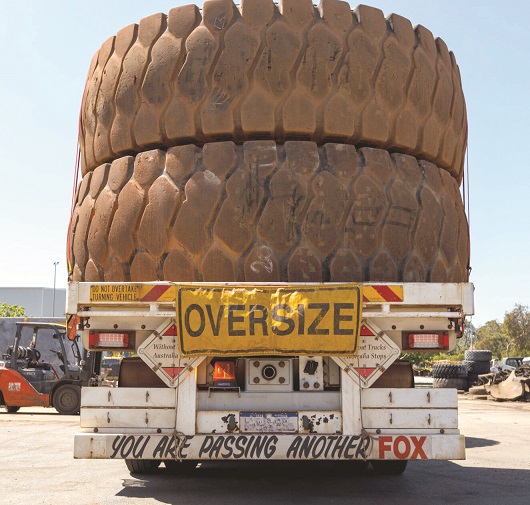 Equipped with a larger primary shredder capable of processing substantial pieces of OTR tyres, the plant in East Rockingham enabled the recycler to manage Alcoa’s tyre waste effectively. Prior trials at the recycler’s New South Wales facility ensured the material could be processed successfully, laying the groundwork for this full-scale collaboration.
Equipped with a larger primary shredder capable of processing substantial pieces of OTR tyres, the plant in East Rockingham enabled the recycler to manage Alcoa’s tyre waste effectively. Prior trials at the recycler’s New South Wales facility ensured the material could be processed successfully, laying the groundwork for this full-scale collaboration.
“Alcoa provides full OTR tyres, which are pre-processed using excavators to reduce size. These pieces are then fed into our fully automated plant, where they undergo a comprehensive process to produce crumb rubber as fine as 700 microns. The crumb rubber is repurposed into road construction material within Western Australia, creating a closed-loop system. The project aligns with the Western Australian Government’s push for the integration of rubber crumb in road infrastructure, ensuring sustainable outcomes,” said Fairweather.
He mentioned that the company has initiated partnerships with major mining operators, securing long-term offtake agreements to convert OTR tyres into value-added products for resale. While agreements are being finalised with several top-tier miners, the company aims to secure additional multi-year contracts, further cementing its position in the growing circular economy of Australia’s resource sector.
PRODUCTION
The company operates nine facilities culminating in a current processing volume of 180,000 tonnes annually with 30 percent spare capacity, allowing for up to 250,000 tonnes per year. Crumb rubber production stands at approximately 25,000 tonnes annually.
While mining tyres constitute a smaller portion of the company’s operations, the bulk of recycling comes from collecting approximately 20 million tyres annually from retail outlets across Australia, including regions such as Far North Queensland, Tasmania, Perth and the Pilbara. These include PCR, TBR, four-wheel-drive tyres, forklift tyres and even bicycle tyres. Roughly 80,000 tyres are collected daily.
Alcoa’s waste OTR tyres are entirely processed into crumb rubber for the Western Australian market. Beyond this, crumb rubber from other ELTs is sold into sectors such as the steel industry, adhesives manufacturing, playground surfacing, walking trails and civil applications. While these sectors are important, they don’t match the volumes required for road construction in Australia.
Additionally, tyre derived fuel (TDF) is manufactured in various sizes to cater to different customer needs. For example, 1.5-inch steel-free chips are used in power boilers, while 2-inch, 3-inch, 4-inch and 6-inch chips are utilised in cement kilns, both locally and for export to countries like Japan.
Offshore customers further process these materials into products like micronised rubber powder. The company also supplies feedstock to large tyre recycling businesses in India and Korea.
Commenting on whether Alcoa takes any of the tyre-derived product under the agreement, Fairweather informed, “Alcoa currently does not take any products, but there are opportunities in development, particularly in the smelting sector, where materials could be used as reductants.”
CONSUMPTION
While crumb rubber production serves local markets exclusively, TDF and steel exports continue to play a vital role in the company’s global strategy with a focus on improving quality and expanding domestic utilisation.
“The crumb rubber produced is fully consumed within Australia, reflecting a strong domestic demand for applications such as road construction. While 5,000 tonnes of TDF is consumed domestically in New South Wales, the vast majority – over 100,000 tonnes – is exported. That said, domestic consumption of TDF is poised to increase significantly with plans to redirect approximately 100,000 tonnes for use within Australia as part of ongoing pipeline development projects,” said the executive.
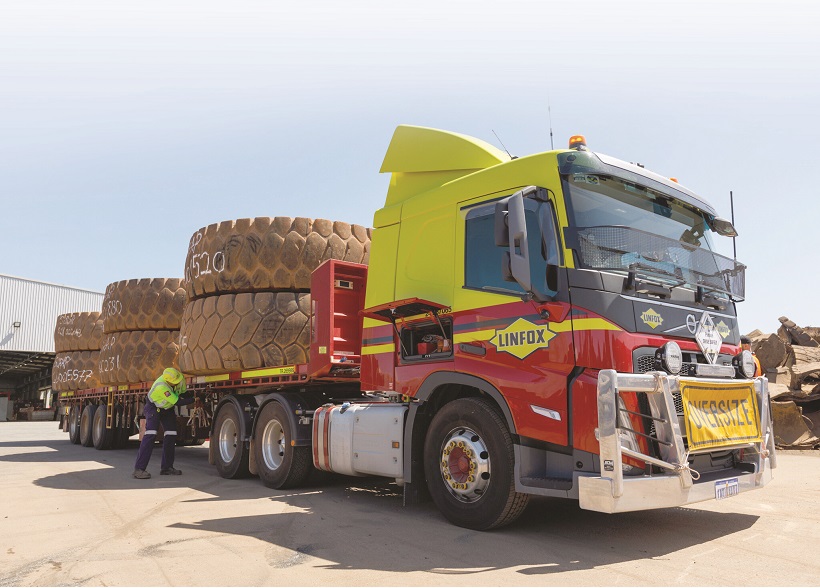
“Additionally, steel extracted from the tyres is traded globally as scrap. With the installation of steel-cleaning systems across all facilities, we now export steel with a much lower rubber contamination rate, reduced from 20 percent to 1-2 percent. This enhancement improves the value of the scrap and allows for more competitive pricing at the collection stage,” he added.
Commenting on the use of crumb rubber for roads, he said, “Road construction remains the largest consumer of crumb rubber in Australia, outpacing other uses. The Western Australian Government’s mandate to use crumb rubber in roads has been evolving over the past three years. Three years ago, there was virtually no sale of crumb rubber for road construction in Western Australia. However, today, Western Australia has become the second-largest market for crumb rubber used in roads across the country, despite having only 10–15 percent of Australia’s population.”
“The Main Roads Western Australia agency played a pivotal role by mandating crumb rubber in road specifications, significantly increasing demand. Additionally, the Western Australian Government supported this initiative by funding the creation of tyre processing infrastructure. This dual approach that includes stimulating private sector investment while ensuring procurement for recycled materials has been key to making these investments viable,” he added.
QUALITY CONTROL
Fairweather quipped that being one of the largest recyclers in the land has its perks when it comes to quality controls. With an expansive collection network that draws in tyres that are not only manufactured at home but imported from different regions ensures understanding of different chemical compositions.
As for ensuring the quality of crumb rubber, especially for road construction, he said, “We implement rigorous quality control procedures from testing the crumb rubber three times a day across all facilities to ensure that it is consistent and free of impurities. We take specific measures to ensure even sample collection and use advanced software to track and grade the rubber’s size distribution. Chemical tests are also performed periodically to maintain the integrity of the crumb rubber. Given the varied origins of the tyres, the company’s large scale allows it to homogenise these variations, ensuring a high-quality product.”
He added that quality is paramount because contaminants like metal can damage equipment used in road construction and asphalt applications. The company maintains a metal contamination level of less than 0.01 percent, which is crucial for the reliability and functionality of the crumb rubber in its applications.
Regarding the recycling of mining tyres compared to passenger and TBR tyres, he noted that there is a significant difference in the process. “Mining tyres are much larger and require different handling equipment and primary processing. These tyres need to be pre-processed to remove the bead before being reduced to a manageable size. In contrast, passenger and TBR tyres undergo a more standard shredding process, which then leads to various mechanical resizing depending on the final product,” said the executive.
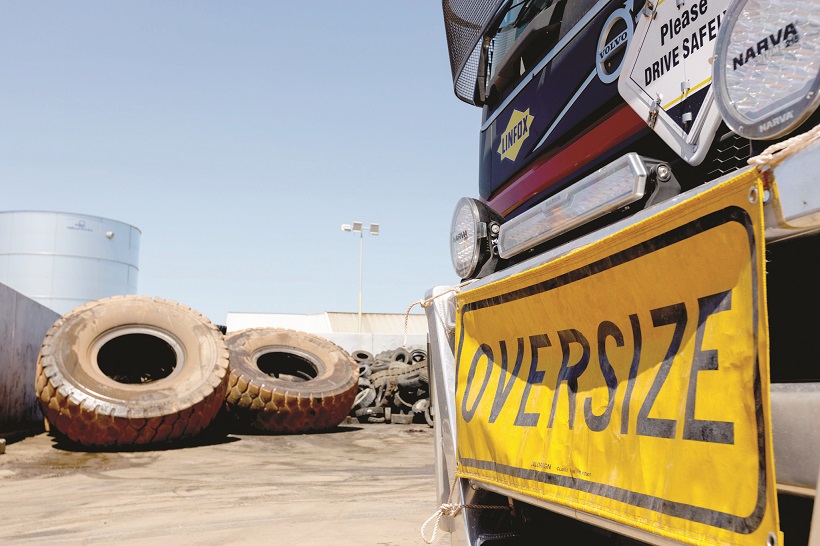
The TDF also goes through a rigorous quality control process.
MARKET FORCES
The largest market for crumb rubber in Australia has historically been Victoria, where it has been widely used in road construction. However, in recent times, Victoria’s market has faced challenges, largely due to budgetary pressures that have led to delays or cancellations of road projects. Despite this, it has remained the leader in crumb rubber consumption for roads.
Western Australia and Queensland are closely matched, coming in second for crumb rubber usage. On the other hand, New South Wales (NSW) and South Australia are behind in their adoption of crumb rubber in road construction, with NSW, particularly Sydney, significantly lagging. This presents an opportunity for growth in those regions, as they could start to increase their usage to match the other mainland states.
Tasmania, due to its smaller population and limited road construction, uses less crumb rubber, but this is proportional to the region’s size and needs.
“The collaboration with Alcoa and the potential for them to purchase products in the future is still under discussion. Both parties are open to exploring further development of this partnership. Alcoa has proven to be a strong partner, and there are good opportunities for continued collaboration, especially in creating a circular process that benefits both Alcoa and the broader market,” averred Fairweather.
The growth strategy for the company focuses on expanding its production capabilities and increasing the value-added nature of its products. This includes ongoing investment in plant infrastructure and a focus on increasing market share, particularly in tyre collection volumes.
The company sees significant potential in the OTR sector, which is currently untapped, and plans to continue developing new products and processes to offer higher-value products rather than just TDF.
TDF, however, remains an essential part of the business. It plays a crucial role in tyre recycling by reducing landfill waste and offering a more environmentally friendly alternative to fossil fuels.
Trials on imported tyres were also successfully completed with full-scale processing set to begin imminently. Tyrecycle also plans to establish processing facilities in Central Queensland and Western New South Wales, reducing logistical barriers and enhancing service capabilities.
Trelleborg Tires Retains Crown As Brazil's Best Agriculture Tyre
- By TT News
- December 07, 2025

For the second consecutive year, Trelleborg Tires has earned the prestigious title of Best Agriculture Tyre at the 22nd Visão Agro Brazil Awards. This 2025 accolade, presented during a ceremony in Ribeirão Preto, highlights the company’s dedicated role in advancing Brazilian agribusiness through technological leadership and a commitment to sustainable practices. The award was received on behalf of the company by Fábio Metidieri, Agri Sales Director for Yokohama TWS Brasil.
Central to this achievement is Trelleborg’s ongoing innovation, particularly the expansion of its ProgressiveTraction technology within the TM tyre series. This engineering, featured in models from the row-crop TM600 to the high-horsepower TM1000, utilises a dual-edge lug design. The tread operates progressively on the soil to enhance traction, promote self-cleaning and minimise vibration. The resulting benefits include improved operational efficiency, increased tyre durability and superior soil protection, directly supporting farmers’ goals for greater productivity and environmental stewardship.
The company’s deep roots in Brazil, supported by a specialised local team, rigorous field testing and strong manufacturer partnerships, ensure its solutions are finely tuned to regional demands. This local infrastructure allows for responsive technical service and keeps product development closely connected to the practical challenges faced by the agricultural sector. The Visão Agro Brazil Awards, judged by a panel of industry executives and researchers, serve as a recognised benchmark for innovation and performance, making this recognition a significant testament to Trelleborg Tires’ impact on the country’s farming landscape.
Metidieri said, “Receiving this award at such a prestigious event once again reinforces our commitment to Brazilian agriculture. Our goal is to keep advancing in technology and field performance, ensuring that every Trelleborg tyre delivers real value – helping farmers operate more efficiently, sustainably and profitably. This award reflects the trust placed in our team and our products by professionals throughout the sector. It strengthens our commitment to delivering technologies that address local challenges and help shape the future of Brazilian farming.”
Premium Makeover
- By Sharad Matade
- December 05, 2025
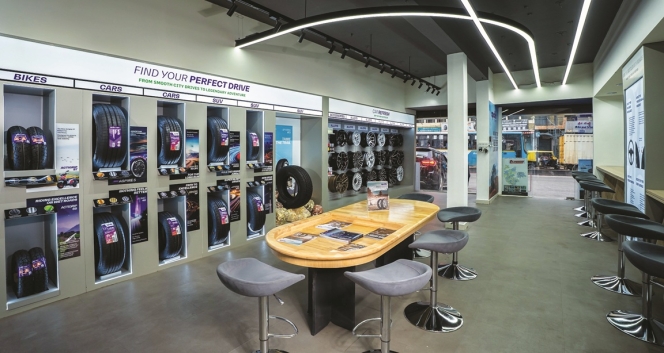
India’s tyre retail industry is undergoing a dramatic makeover, moving far beyond the cluttered workshops and transactional buying of the past. Fuelled by rising demand for premium vehicles, digital-first customers and stronger export momentum, tyre makers are transforming retail spaces into sleek, immersive experience centres. What was once a routine utility purchase is rapidly evolving into a premium, advisory-led mobility experience designed for a new generation of motorists.
India’s tyre retail scene is shifting gears, leaving behind the era of crowded workshops and impersonal counters. In their place, manufacturers are rolling out sleek, thoughtfully designed, tech-powered spaces that echo the luxury of high-end car showrooms. What started as a few bold pilots in big cities has quickly become the go-to playbook for tyre brands eager to win over a new generation of savvy, comfort-loving, digital-first customers.
From urban to rural areas, this transformation reveals a profound change in how Indians approach mobility. Today’s motorists – especially those behind the wheel of SUVs, luxury sedans and electric cars – want more than just a tyre swap. They crave expert advice, a polished atmosphere and a shopping experience that reflects the elegance of their vehicles. Once a utilitarian afterthought, tyre retail is now emerging as a coveted part of the automotive journey.
Strong OEMs and replacement demand in both domestic and export markets underpin the transition.
In FY 24-25, tyre exports from India surged by nine percent year-on-year to INR 251 billion, according to data released by the Ministry of Commerce. With an estimated annual turnover of INR 1 trillion and exports exceeding INR 250 billion, the Indian tyre industry stands out as one of the few manufacturing sectors in the country with a high export-to-turnover ratio.
Though tyre exports have hit a speed bump due to higher US tariffs on select categories of Indian tyres compared to those of competing nations, the long-term prospects for the Indian tyre industry remain strong. According to a joint report by ATMA and PwC India titled ‘Viksit Bharat 2047: Vision and Roadmap for the Indian Tyre Industry’, India’s tyre production volumes are projected to grow nearly fourfold by 2047, while industry revenues are expected to expand almost 12 times to about INR 13 trillion.
Against this backdrop, tyre makers are modernising aggressively to retain customers and build a more profound emotional affinity. The broad shift is visible in how retailers are reinventing their spaces. Lounges with crafted lighting, upholstered seating, minimalist décor and large digital walls are replacing traditional steel racks and dusty counters. Informational murals and heritage display trace decades of tyre innovation, strengthening brand storytelling. Stores increasingly feature curated experience zones where customers can explore tyre technologies, EV-compatible profiles, eco-friendly materials and performance characteristics through visual displays and interactive tools.
A clear sign of this trend is the rise of personalised, advisory-led engagement, replacing the old dependence on technicians. Retailers now profile driving habits, terrain usage, daily distance and vehicle type to recommend tyres customised to each consumer’s pattern. This service-led model is shifting the customer’s mindset from price-first decision-making to long-term value evaluation.
The new premium outlets are designed to deliver a lifestyle-driven, hospitality-grade experience rather than a traditional tyre shop visit. Customers receive personalised mobility recommendations tailored to their vehicle, driving style and needs, supported by smart service innovations like intelligent product selection, quick-fit services and digital scheduling. The space also acts as a community hub for driving enthusiasts, creating a connected ecosystem around the brand. With lounge-style comfort, immersive storytelling and specialised tyre and service packages for luxury and performance vehicles, the outlet blends convenience, premium care and brand-centric offerings into an elevated customer experience.
“Customer experience at the point of sale is another branding exercise poised to change buyer characteristics. Multi-brand outlets often commoditise the tyre-buying experience. That’s why companies are launching exclusive brand outlets with curated customer experiences. Over the next decade, new delivery models will emerge,” said Kavan Mukhtyar, Partner and Leader – Automotive, PwC India.
Apollo Tyres articulates this change as a move towards lifestyle-led retailing. Its new super-premium outlets have been built not as showrooms but as emotionally resonant spaces.

Udyan Ghai, Group Head of Marketing at Apollo Tyres, explained that the company’s new retail architecture is anchored in long-term strategic priorities: “Our move to a lifestyle-led, immersive tyre retail format is driven by our own desire for premiumisation and category leadership. We are looking at elevating tyre retail in India by setting new benchmarks and shifting from commodity selling to a premium, lifestyle-driven experience.”
He said the brand aims to ‘emotionally engage with customers, offer tailored solutions, build a community of driving enthusiasts and tap into premium segments – all while delivering a differentiated, modern retail experience’.
Ghai believes retail ambience plays a decisive role in influencing perception. “A relaxed and well-designed lounge signals comfort, trust and premium value,” he said, adding that such environments elevate tyres from a mundane requirement to a core element of vehicle care and identity.
Digital transparency, he believes, is the second pillar of modern tyre retail. “Digital systems ensure transparency and help demystify tyre selection – tread patterns, speed ratings, durability and fitment. Consumers feel less dependent on a technician’s word and more in control, which boosts their confidence and perceived fairness,” Ghai said.
Customers today are inundated with choices, and digital systems, he said, turn tyre buying into an ‘informed, personalised decision’, comparable to selecting a smartphone, a pair of performance shoes or even a detailed insurance plan. According to Ghai, this new retail model is ‘a strategic investment in the future of mobility retail’, designed to be scalable and to support community-building events, workshops and enthusiast interactions. As India moves towards EVs and connected cars, he said these premium outlets will provide EV-focused tyre expertise, interactive digital tools and personalised recommendations that appeal to younger, digitally savvy motorists.
CEAT shares a similar philosophy. Its national retail revamp focuses heavily on digital immersion, consistent messaging and design-led layouts. Lakshminarayanan B, the company’s Chief Marketing Officer, said the modernised CEAT Shoppes are fundamentally reshaping the category.

“The modern layouts and digital integration in CEAT Shoppes are revolutionising the tyre-buying experience, making it more experiential and customer-centric,” he said, adding that these updated outlets elevate the experience, build trust through uniform communication and drive decisions by reducing ambiguity around features and value.
Lakshminarayanan highlighted CEAT’s attempt to harmonise customer experience across demographics: “The approach in urban markets through premium stores, product offerings and services is to create access and aspiration for premium customers. The same is replicated in upcountry markets also.”
The CEAT Executive said the company is building for a future where personalisation will be the defining characteristic of tyre retail. “CEAT is focused to drive the future of tyre retail through end-to-end personalisation,” he said.
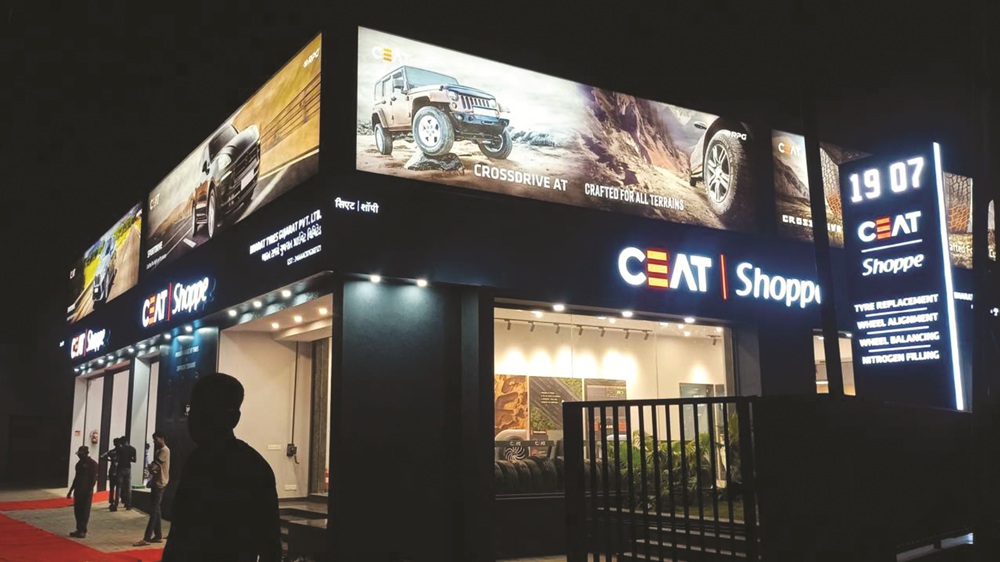
As experiential retail takes hold, service portfolios inside tyre stores are expanding faster than ever. Advanced wheel balancing, laser-driven alignment systems, nitrogen inflation, premium alloy wheel installations, EV-oriented tyre consultations, digital appointment scheduling and real-time tyre-health diagnostics are now standard. Many outlets also provide car detailing, interior cleaning, ceramic coating, PPF application, brake checks, battery inspections and multi-point vehicle health reports, making them full-fledged mobility centres.
Global players have pushed the envelope even further. Michelin’s 25,000-square-foot Experience Store in Nashik features a heritage wall and innovation displays showcasing electric mobility, materials science and environmental responsibility. It houses precision wheel-alignment bays, detailing studios, and accessory galleries. “We are proud to unveil Michelin’s first Experience Centre in India. The sole purpose of this store is to go beyond traditional tyre retail and provide customers with an immersive experience of the brand,” said Shantanu Deshpande, Managing Director of Michelin India.
Continental Tyres is also strengthening India’s premium retail ecosystem through its CPD outlets, which include ambient lounges, diagnostic equipment, premium alloy wheels and digitally enabled guidance. “With our new CPD store in Indore, we bring Continental’s promise of safety, innovation and comfort closer to Madhya Pradesh’s clients,” said Samir Gupta, Managing Director of Continental Tyres India. He added that the brand’s ‘In the Market, For the Market’ approach is central to its retail expansion strategy.
Even in rural markets, tyre retail is becoming more formalised, structured and service-oriented. JK Tyre’s ‘Steel Wheels’ format is targeted at towns with populations under 100,000 and offers standardised layouts, value-added services, best-in-market pricing and instant claim facilities. “Our Rural expansion programme will help us reach the interiors of the real Bharat that is economically vibrant but often underserved. We are not just building retail points; we are also enabling entrepreneurship and access,” said Managing Director Anshuman Singhania.
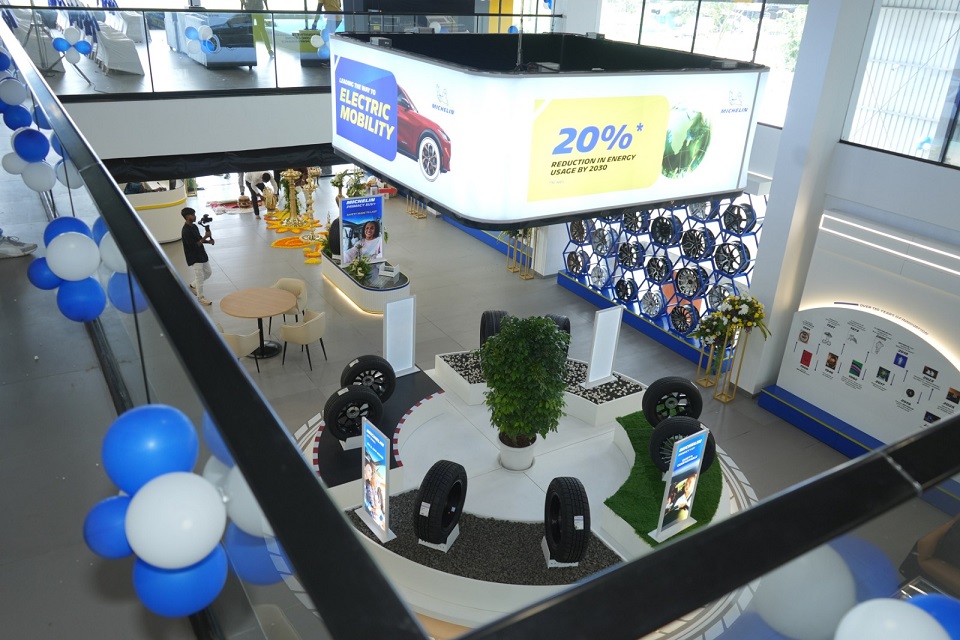 Together, these developments mark a decisive shift in how tyre brands engage customers. Tyre stores are increasingly functioning as lifestyle environments, designed for comfort, informed decision-making, personalisation, transparency and community. The industry is moving away from a product-first mindset to a customer-experience-led philosophy.
Together, these developments mark a decisive shift in how tyre brands engage customers. Tyre stores are increasingly functioning as lifestyle environments, designed for comfort, informed decision-making, personalisation, transparency and community. The industry is moving away from a product-first mindset to a customer-experience-led philosophy.
As premium cars, SUVs and EVs become mainstream, and as younger motorists prioritise digital empowerment and ambience, tyre retailers are aligning with these new expectations. India’s tyre makers are building a retail landscape where experiential engagement, technology integration, service breadth and emotional connection define long-term brand success.
For an industry long anchored in grease, metal and functionality, the transformation is profound. Tyre retail in India is no longer just about fitment; it is becoming a premium mobility experience, curated for a generation that demands clarity, comfort and an elevated relationship with every aspect of vehicle ownership.
Kumho Tire To Build First European Plant In Poland With $587mln Investment
- By TT News
- December 05, 2025
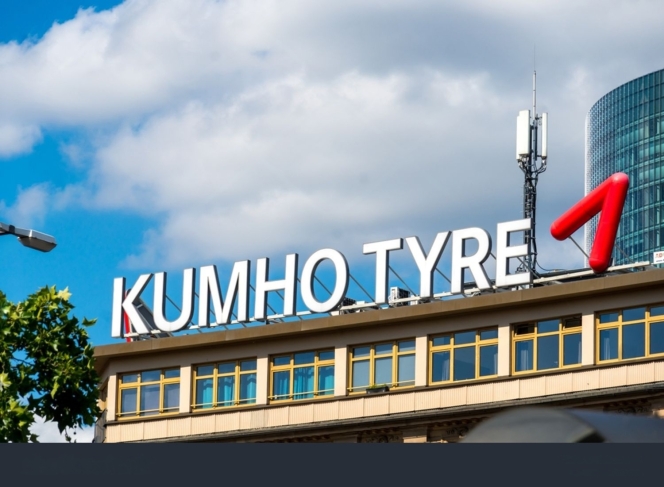
Kumho Tire will establish its first European manufacturing plant in Poland’s Opole region as the South Korean company seeks to expand its position in one of the world’s largest tyre markets.
The group said the factory is scheduled to begin initial operations in August 2028, subject to investment approval and licensing. Kumho plans to produce 6m units annually in the first phase and expand capacity in line with demand. Total planned investment is USD 587 million.
Kumho has spent recent years evaluating multiple European locations, including Poland, based on logistics, labour availability, infrastructure, market access and investment incentives. The company said Opole was selected as the optimal site owing to supply-chain stability within the EU and the region’s supportive operating conditions.
Europe accounts for about a quarter of global tyre consumption and is home to several major automotive manufacturers. The region represented roughly 26.6 per cent of Kumho’s sales last year. The company has previously relied on exports to serve European customers, which it said limited its competitiveness in the market.
The new plant is intended to strengthen Kumho’s ability to supply high-value-added products, including high-performance and larger-diameter tyres, to European vehicle makers.
Kumho currently operates eight production sites across South Korea, China, the US and Vietnam, with combined annual output of 65 millionunits. The Polish plant will complete what the company describes as a production network spanning Asia, Europe and North America.
Jung Il-taek, Kumho Tire’s Chief Executive, said: “The European market occupies a very important strategic position in the global tire industry,” adding that “Kumho Tire will go beyond simple exports and dramatically enhance premium brand value by strengthening quality and service competitiveness through local European production and supply.”
Tyre Stewardship Australia Appoints David Fraser As Chair As David Spear Steps Down
- By TT News
- December 04, 2025
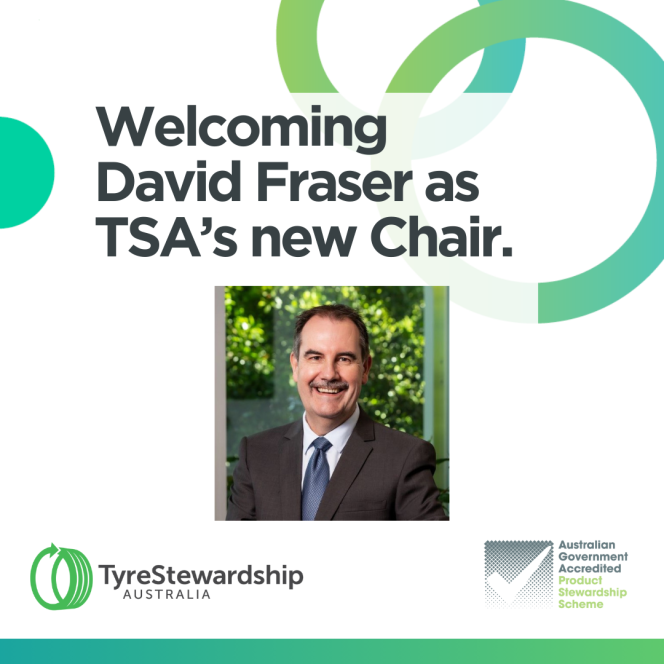
Tyre Stewardship Australia has appointed David Fraser as its new chair, succeeding David Spear after nine years in the role during a period of regulatory and industry change in the country’s tyre-recycling sector.
Spear’s departure closes what the organisation described as a challenging yet incredibly important chapter for its efforts to advance circular outcomes for Australia’s end-of-life tyres. TSA, an industry body backed by government and sector participants, oversees the national stewardship scheme and promotes recycling and re-use pathways for waste tyres, an area facing increasing scrutiny under Australia’s environmental and product-stewardship policies.
In a statement, TSA said it “thank[s] him for his unwavering support and dedication to driving circular outcomes for Australia’s end-of-life tyres”.
Fraser, a TSA director since 2023, brings experience in governance and compliance. He joins at a time when Australian states are tightening environmental standards and seeking to reduce landfill through higher recycling targets. TSA said Fraser has “deep understanding of our strategy, our challenges and the opportunities ahead”.
The organisation added: “We look forward to his leadership as TSA enters its next chapter.”
TSA also expressed appreciation to Spear “for your contribution and support of our mission”, and welcomed Fraser, saying it is “excited and ready for what lies ahead”.







Comments (0)
ADD COMMENT